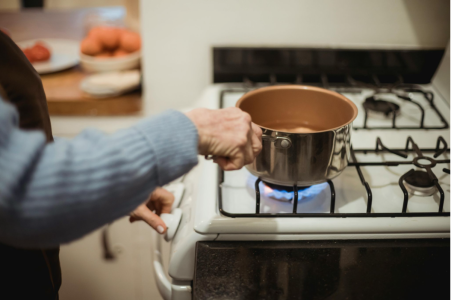Everyday household items could be harming your health—here’s how to stay safe
By
Aubrey Razon
- Replies 0
Your home may feel like a safe space, but hidden health risks could be lurking in your everyday routine. For women especially, certain household items might pose unexpected dangers.
Stay tuned as we reveal what to watch out for and how to protect yourself.
Recent research has raised red flags about the potential health hazards associated with gas stoves and cleaning products—hazards that disproportionately affect women.
Dr. Mary Margaret Johnson from Harvard T.H. Chan School of Public Health highlights that women's frequent use of these items can lead to increased health risks, particularly respiratory problems.
Studies have estimated that nitrogen dioxide emissions from gas stoves contribute to tens of thousands of asthma cases nationwide.
Even more concerning, children in homes with gas stoves have a higher risk of developing asthma, with girls being particularly vulnerable.
Gas stoves emit not only nitrogen dioxide but also fine particulate matter (PM2.5) and benzene, a known carcinogen.
These pollutants can have long-term health effects, including an increased risk of leukemia and possibly even neurological diseases like dementia.
A study in the Journal of Allergy and Clinical Immunology found that regular use of household disinfectants and cleaning products could lead to uncontrolled asthma.
Chemicals such as quaternary ammonium and limonene, which give products their fresh citrus scent, can irritate the respiratory system and skin.
Moreover, mixing certain cleaning agents can release harmful gases, adding to the indoor air pollution that already plagues many homes.
1. Rethink Your Range
If you're in a position to replace your gas stove, consider opting for an electric or induction model. These alternatives do not emit the harmful pollutants associated with gas stoves.
2. Ventilation is Vital
Improve kitchen ventilation by using exhaust hoods and opening windows while cooking. An air purifier can also help reduce indoor air pollution.
3. Minimize Stove Use
Explore cooking methods that don't require a gas stove, such as electric kettles, air fryers, or multi-cookers.
4. Protective Gear
When cleaning, wear gloves to protect your skin and consider a mask if you have respiratory conditions or want extra protection.
5. Choose Wisely
Select fragrance-free cleaning products with certifications from Safer Choice, Green Seal, or EcoLogo. Alternatively, use natural cleaning agents like baking soda and vinegar.
6. Read Labels
Pay close attention to warnings on cleaning products to avoid dangerous chemical combinations.
Remember, the power to create a safer, healthier home is in your hands. By making informed decisions and adopting safer practices, you can significantly reduce the risks and breathe easier in the comfort of your home.
 Have you made changes to your cooking or cleaning habits to protect your health? Do you have any home remedies or natural solutions that you swear by? Share your advice in the comments below.
Have you made changes to your cooking or cleaning habits to protect your health? Do you have any home remedies or natural solutions that you swear by? Share your advice in the comments below.
Stay tuned as we reveal what to watch out for and how to protect yourself.
Recent research has raised red flags about the potential health hazards associated with gas stoves and cleaning products—hazards that disproportionately affect women.
Dr. Mary Margaret Johnson from Harvard T.H. Chan School of Public Health highlights that women's frequent use of these items can lead to increased health risks, particularly respiratory problems.
Cooking Concerns: Gas Stoves and Your Health
The act of cooking, a task often more frequently performed by women, can expose them to harmful pollutants.Studies have estimated that nitrogen dioxide emissions from gas stoves contribute to tens of thousands of asthma cases nationwide.
Even more concerning, children in homes with gas stoves have a higher risk of developing asthma, with girls being particularly vulnerable.
Gas stoves emit not only nitrogen dioxide but also fine particulate matter (PM2.5) and benzene, a known carcinogen.
These pollutants can have long-term health effects, including an increased risk of leukemia and possibly even neurological diseases like dementia.
Cleaning Products: A Chemical Cocktail
Cleaning is another area where women typically have more exposure, and it comes with its own set of risks.A study in the Journal of Allergy and Clinical Immunology found that regular use of household disinfectants and cleaning products could lead to uncontrolled asthma.
Chemicals such as quaternary ammonium and limonene, which give products their fresh citrus scent, can irritate the respiratory system and skin.
Moreover, mixing certain cleaning agents can release harmful gases, adding to the indoor air pollution that already plagues many homes.
Strategies for a Safer Environment
While these findings may be concerning, there are ways to mitigate the risks and protect your health:1. Rethink Your Range
If you're in a position to replace your gas stove, consider opting for an electric or induction model. These alternatives do not emit the harmful pollutants associated with gas stoves.
2. Ventilation is Vital
Improve kitchen ventilation by using exhaust hoods and opening windows while cooking. An air purifier can also help reduce indoor air pollution.
3. Minimize Stove Use
Explore cooking methods that don't require a gas stove, such as electric kettles, air fryers, or multi-cookers.
4. Protective Gear
When cleaning, wear gloves to protect your skin and consider a mask if you have respiratory conditions or want extra protection.
5. Choose Wisely
Select fragrance-free cleaning products with certifications from Safer Choice, Green Seal, or EcoLogo. Alternatively, use natural cleaning agents like baking soda and vinegar.
6. Read Labels
Pay close attention to warnings on cleaning products to avoid dangerous chemical combinations.
Remember, the power to create a safer, healthier home is in your hands. By making informed decisions and adopting safer practices, you can significantly reduce the risks and breathe easier in the comfort of your home.
Key Takeaways
- Women are disproportionately affected by household hazards such as gas stoves and cleaning products due to higher usage rates for cooking and cleaning.
- Studies have linked gas stove usage and certain cleaning chemicals to increased respiratory issues and health risks, including asthma and potential carcinogen exposure.
- Improving ventilation, using air purifiers, and opting for safer alternatives like electric or induction stoves and less harmful cleaning products can help protect health.
- Awareness and proper usage guidelines, including proper ventilation and labelled warnings on cleaning products, are essential for minimising health risks at home.







